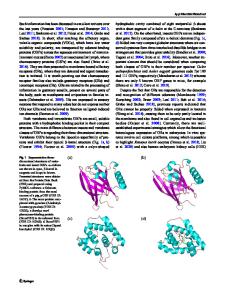Exploring the Potential of Two Bacterial Consortia to Degrade Cellulosic Biomass for Biotechnological Applications
- PDF / 1,152,106 Bytes
- 11 Pages / 595.276 x 790.866 pts Page_size
- 20 Downloads / 326 Views
Exploring the Potential of Two Bacterial Consortia to Degrade Cellulosic Biomass for Biotechnological Applications Milena Tavares Lima Constancio1 · Laís Postai Sacco1 · João Carlos Campanharo1 · Tereza Cristina Luque Castellane1 · Anna Carolina de Oliveira Souza1 · Bruno Weiss1 · Alessandro de Mello Varani1 · Lúcia Maria Carareto Alves1 Received: 5 February 2020 / Accepted: 15 July 2020 © Springer Science+Business Media, LLC, part of Springer Nature 2020
Abstract This paper outlines two cellulolytic bacterial consortia named SCS and SCB, isolated from soil samples of sugarcane (Saccharum officinarum) crop field, and a sugarcane bagasse deposit in an ethanol mill. Both consortia were able to grow on different carbon sources, such as sugarcane bagasse, corn husk, peanut hulls, and carboxymethylcellulose, releasing up to 11.90 µmol/mL and 15.23 µmol/mL of glucose for SCS and SCB, respectively. In addition, SCS and SCB have several strains capable of producing cellulase, amylase, lipase, and protease. Whole genome sequencing of the SCS consortium revealed that Burkholderia was the most prevalent genus, encompassing approximately 80% of the consortia. In addition, metagenome analysis allowed the identification of genes encoding enzymes related to starch and cellulose degradation, as well as enzymes related to lipases and proteases, confirming our initial findings. The results showed that SCS and SCB had the capability to degrade cellulose, and that they were an efficient source of enzyme production, which would provide a new choice for use in different biotechnological applications.
Introduction Milena Tavares Lima Constancio and Laís Postai Sacco are equally contributed. * Lúcia Maria Carareto Alves [email protected]
Milena Tavares Lima Constancio [email protected]; [email protected]
Laís Postai Sacco [email protected] João Carlos Campanharo [email protected] Tereza Cristina Luque Castellane [email protected] Anna Carolina de Oliveira Souza [email protected] Bruno Weiss [email protected] Alessandro de Mello Varani [email protected] 1
Department of Technology, São Paulo State University (UNESP), School of Agricultural and Veterinarian Sciences, Via de Acesso Prof. Paulo Donato Castellane, s/n, Jaboticabal, SP 14884‑900, Brazil
The lignocellulosic biomass is a viable option for replacement of petroleum derivatives and an alternative to biofuel production. Agricultural wastes, such as sugarcane bagasse, shells, and even forest residues are examples of biomass derivative materials, which are rich in carbohydrates, lignin, proteins, fats, and to a lesser extent, various other substances such as vitamins. Due to its complex and compact structure, the lignocellulosic biomass is not easily broken down to monosaccharides. However, micro-organisms are known to degrade lignocellulose cooperatively [1]. The cooperation of microorganisms in degrading or metabolizing compounds is commonly referred to as microbial consortium. There are different microbial communitie
Data Loading...











